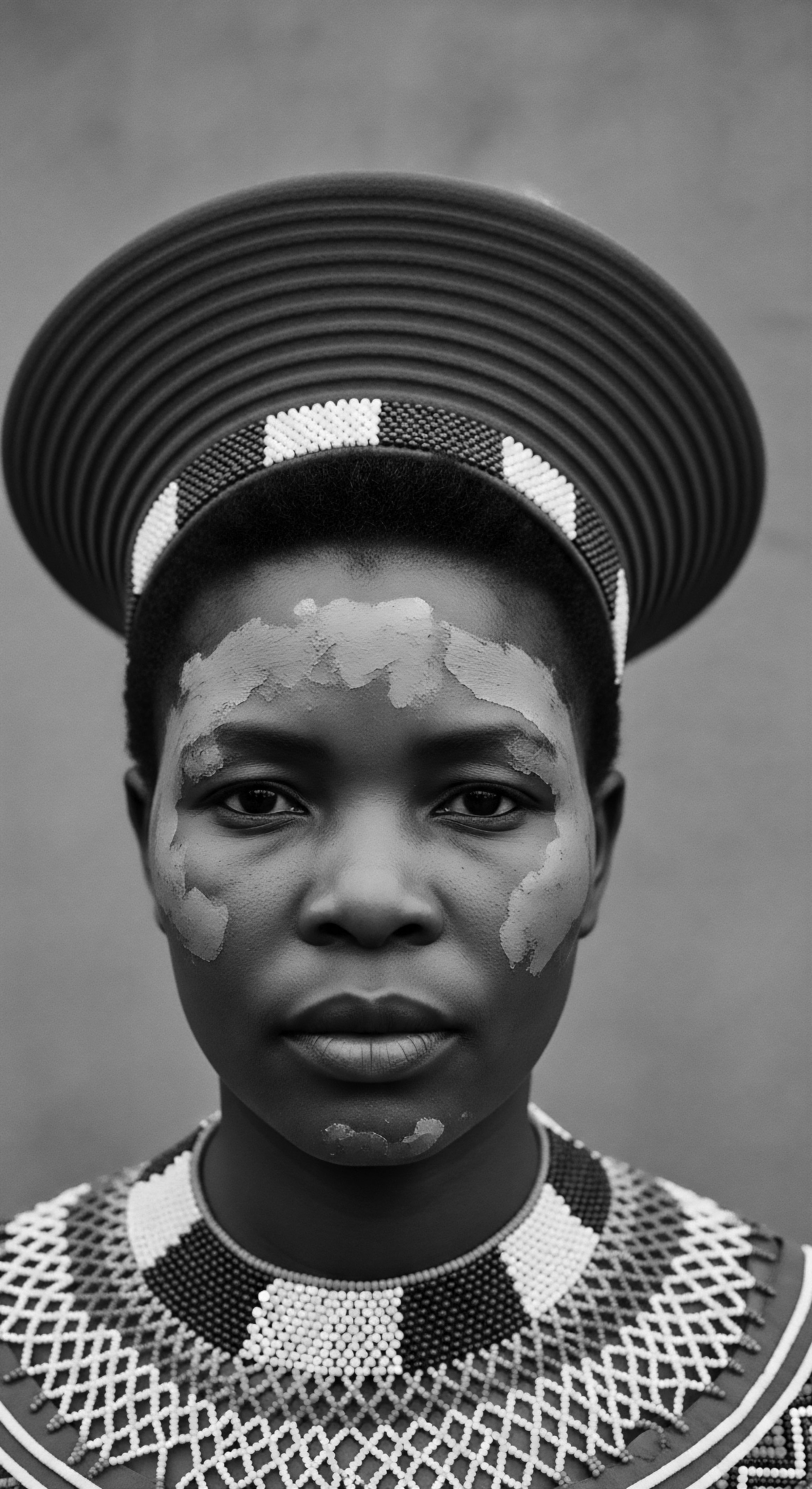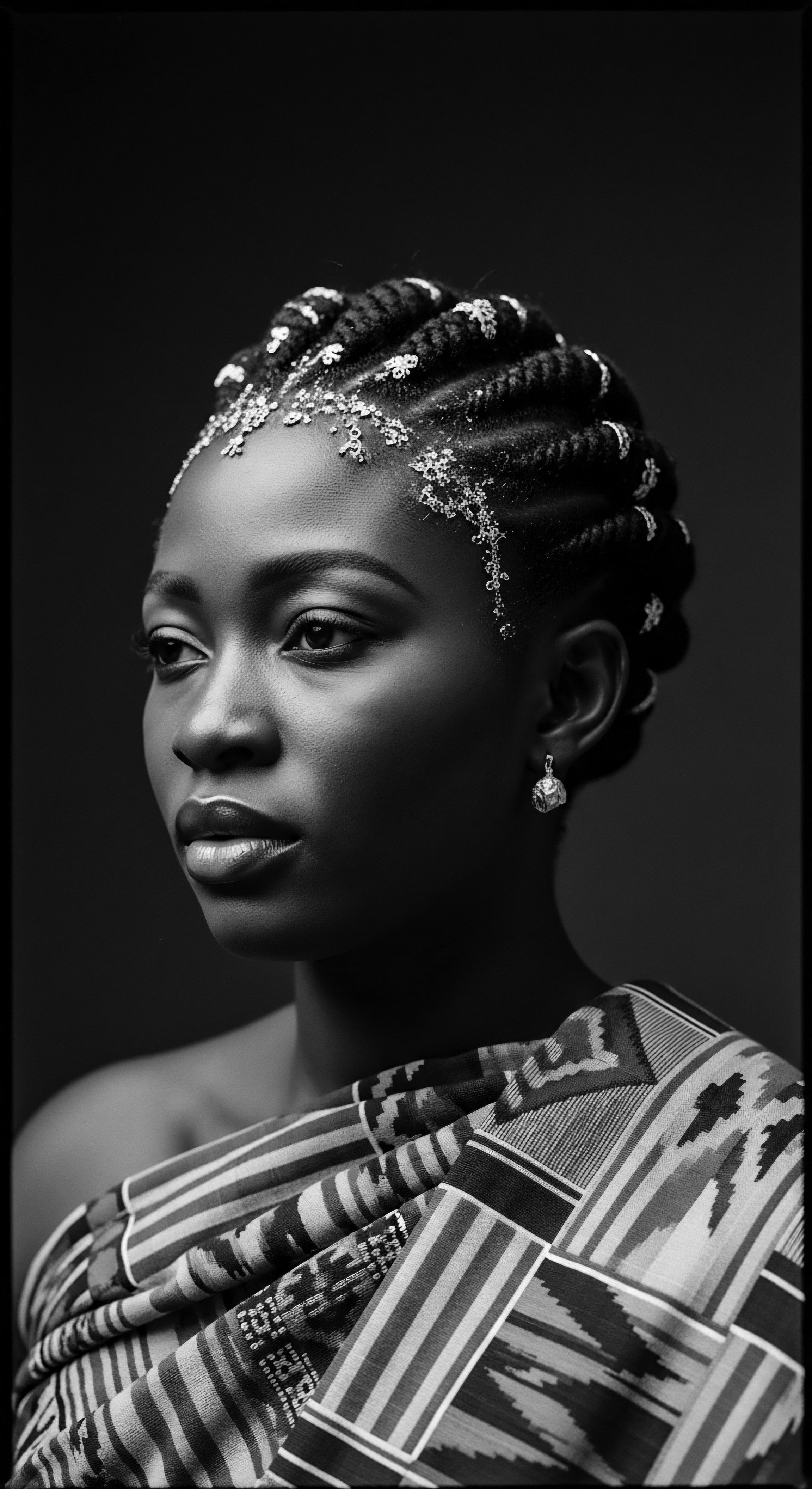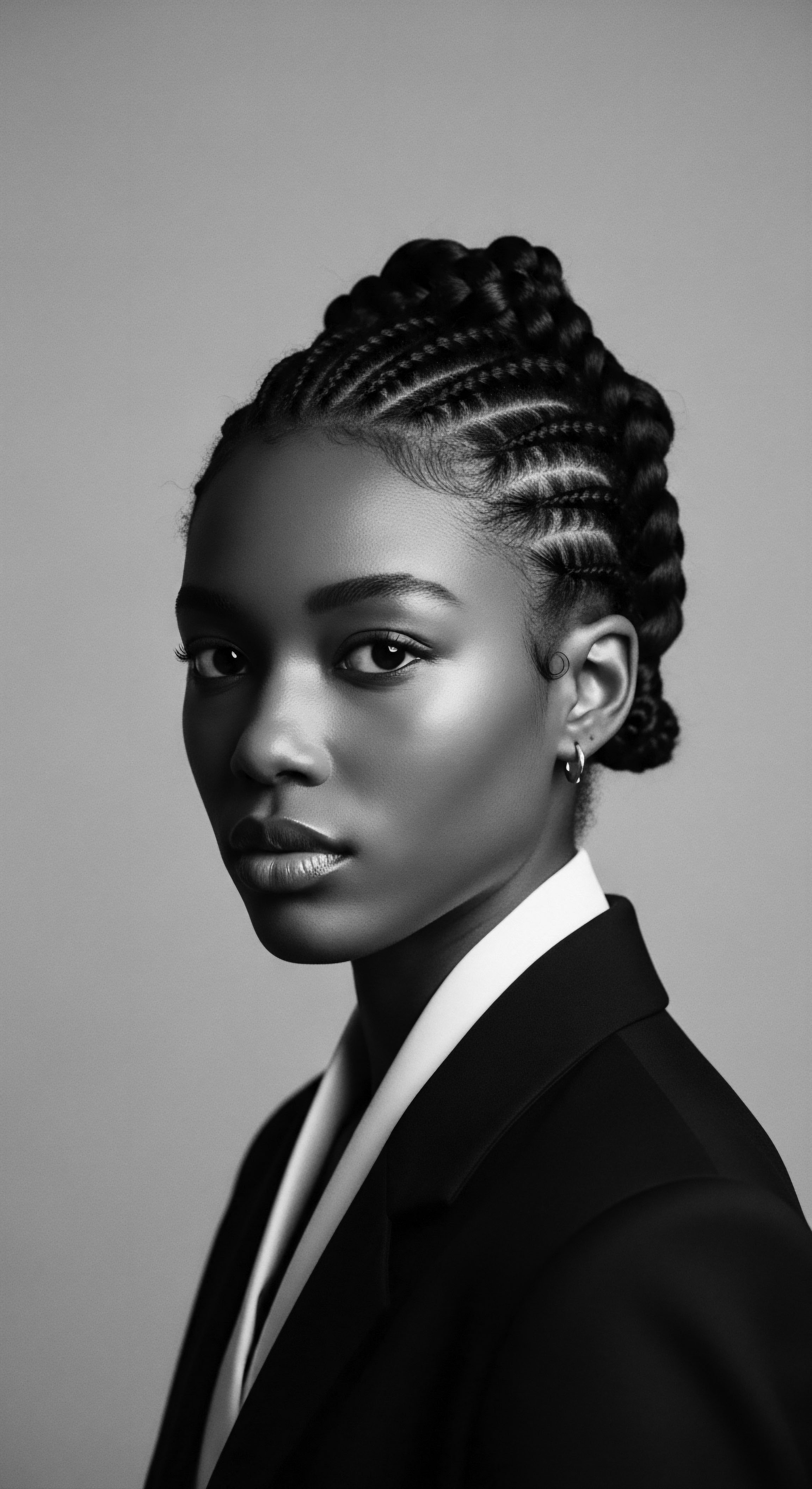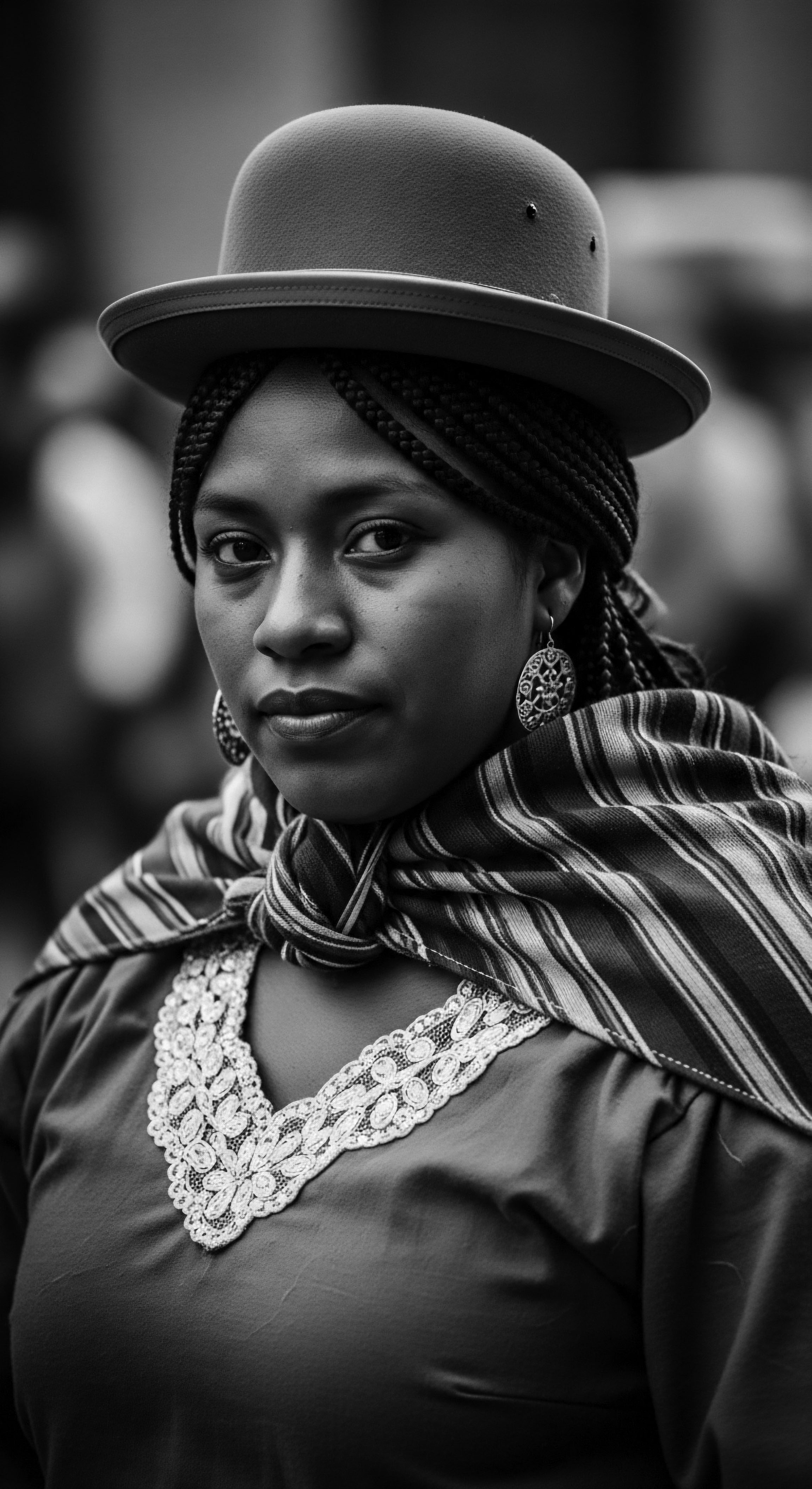
Fundamentals
The concept of Heritage Dyes offers a profound meditation on the elemental substances that have, since time immemorial, graced and colored the strands of humanity, particularly those of textured hair. This interpretation reaches beyond mere hue, speaking to the deep cultural meaning and traditional practices that define these natural colorants. It delineates them not as chemical compounds synthesized in laboratories, but as echoes from the very earth and flora, carrying within them the wisdom of countless generations. This designation encompasses the plant-derived pigments, mineral earths, and other organic materials utilized by ancestral communities to adorn, protect, and signify through hair.
At its core, a Heritage Dye is a substance whose use for hair modification is inextricably linked to the lineage and customs of a people. The description of these agents often includes their preparation from natural sources, their application methods passed down through oral traditions, and the spiritual or social significance they held within their societies. Clarification surrounds their distinction from modern, synthetic dyes, which operate on different chemical principles and often carry a detached, commercial lineage. This form of coloration, instead, is a living artifact, a testament to ingenious ancestral understanding of natural properties.

What Defines a Heritage Dye?
A Heritage Dye, in its most straightforward sense, is a natural material employed to alter the pigmentation of hair, drawing its efficacy from the earth’s abundant gifts. Its character is defined not solely by its coloring ability, but by the generational knowledge embedded within its use. The explication of such a dye necessitates an appreciation for the specific ecosystems that yielded its components and the human ingenuity that transformed raw materials into vibrant expressions upon the scalp.
- Origin ❉ These colorants arise directly from botanical sources, such as leaves, roots, bark, or flowers, or from geological deposits, like clays and mineral oxides.
- Ancestral Application ❉ Their methods of preparation and application have been refined over centuries, often involving communal rituals, specific tools, and a reverence for the natural world.
- Cultural Significance ❉ Beyond their aesthetic purpose, Heritage Dyes carried profound symbolic weight, marking rites of passage, social status, spiritual connection, or even resistance.
The designation “Heritage Dyes” illuminates a path back to the origins of human adornment, recognizing that the desire to express identity through hair color is not a modern phenomenon. It is an ancient longing, fulfilled for millennia by what the natural world provided.

The First Footprints of Color
The earliest human communities, long before the dawn of written history, perceived the world in a spectrum of earthy tones. They learned to coax color from berries, barks, and ochres, applying these findings to textiles, skin, and hair. The ancestral understanding of these materials’ properties formed the rudimentary science behind what we now term Heritage Dyes. These early engagements with natural color laid the groundwork for sophisticated practices that would unfold across continents and generations.
Evidence of hair adornment, including coloration, emerges from archaeological records spanning thousands of years. From ancient Egypt to pre-colonial Africa, indigenous Americas to ancient India, human beings sought to express their inner worlds on the outer canvas of their hair. The choice of color, the method of its application, and the stories woven into these practices became intricate threads in the cultural fabric of a people.
Heritage Dyes represent an unbroken lineage of human ingenuity, transforming earth’s gifts into expressions of identity upon textured hair strands.
The initial meaning of altering hair’s appearance often transcended mere decoration. It often related to spiritual protection, tribal affiliation, or markers of age and wisdom. This depth of intention imbues Heritage Dyes with a resonance that contemporary chemical formulations, for all their technical brilliance, struggle to replicate.

Intermediate
Moving beyond a basic understanding, an intermediate appreciation of Heritage Dyes demands a closer examination of their inherent significance and the intricate relationship they share with textured hair. This deeper interpretation acknowledges the dynamic interplay between the elemental biology of the dyes themselves and the diverse, resilient structures of Black and mixed-race hair. It compels us to consider how ancient wisdom, often conveyed through meticulous ritual, aligned with, and indeed preceded, modern scientific comprehension.
The term “Heritage Dyes” thus becomes a lens through which to observe a continuous stream of knowledge, flowing from ancestral practices to contemporary applications. The understanding of this continuity allows for a richer appreciation of why certain plants or minerals were chosen and how their properties were harnessed with remarkable efficacy, long before the advent of molecular chemistry. The purpose of these colorants extended beyond superficial alteration, often acting as protective agents, conditioners, and even spiritual conduits.

Beyond Pigment ❉ A Cultural Lens
The true impact of Heritage Dyes lies in their profound cultural connotations. For countless communities with textured hair, these substances were not simply cosmetic; they were deeply integrated into social structures, spiritual beliefs, and personal narratives. The application of these dyes often involved communal gatherings, songs, and prayers, transforming a beauty ritual into a collective affirmation of identity and belonging.
- Social Markers ❉ Particular shades or application patterns could indicate marital status, age-grade initiation, or leadership roles within a community.
- Spiritual Connection ❉ Certain mineral-based dyes, such as red ochre, were perceived to possess protective or spiritual properties, guarding against negative influences or connecting individuals to their ancestors.
- Healing and Protection ❉ Many plant-based dyes carried medicinal qualities, providing anti-fungal benefits or environmental protection for the hair and scalp, especially in harsh climates.
This cultural depth provides the true definition of a Heritage Dye. Its substance is not merely its chemical composition, but the centuries of lived experience, tradition, and shared meaning it represents. The choices made by ancestors regarding what to use for hair coloration were often imbued with practical wisdom and spiritual reverence, a holistic view of well-being that is now being rediscovered.

Hair’s Chemistry and Ancestral Wisdom
To grasp the scientific essence of Heritage Dyes, one must consider the unique architecture of textured hair itself. Its helix-like structure, often characterized by intricate curl patterns, presents distinct challenges and opportunities for color uptake. Ancestral practitioners, through generations of keen observation, developed sophisticated methods to prepare and apply these dyes, ensuring optimal adhesion and lasting vibrancy without causing harm to the delicate hair shaft.
Consider, for instance, the preparation of certain plant dyes, which often involved fermentation or specific heating processes. These steps, understood intuitively by traditional artisans, align with modern biochemical principles that facilitate the release of stable chromophores—the color-bearing molecules—and aid their penetration into the hair’s cuticle. The selection of specific binders or emollients, such as oils or clays, further demonstrates a pragmatic understanding of how to protect and condition the hair while imparting color.
Heritage Dyes reveal an ancient understanding of natural chemistry, a symbiotic relationship between indigenous resources and the unique properties of textured hair.
The interplay of the dye’s molecular structure with the hair’s keratin bonds, though not articulated in scientific terms, was nevertheless managed with remarkable precision through trial and error over millennia. This empirical science, honed by observation and passed down orally, laid the foundation for effective and gentle hair coloration that respected the hair’s intrinsic nature.

Continuity of Adornment
The journey of Heritage Dyes from distant past to the present day embodies a powerful continuity, a tender thread connecting descendants to their forebears. Even amidst the widespread availability of synthetic options, many individuals with textured hair consciously seek out and revive these traditional practices. This phenomenon speaks to a longing for authenticity, a desire to honor ancestral ways, and a recognition of the inherent benefits often absent in modern alternatives.
The revival of traditional hair care, including the application of natural colorants, serves as a powerful act of reclamation. It is a conscious choice to align personal beauty practices with a heritage of self-care and communal knowledge, a quiet defiance against narratives that historically devalued textured hair. This contemporary re-engagement further cements the meaning of “Heritage Dyes” as not just historical relics, but as living, breathing components of identity formation and cultural affirmation.

Academic
The academic definition of Heritage Dyes requires a rigorous, multi-disciplinary approach, examining their elemental composition, cultural anthropology, and historical trajectories, particularly as they relate to the complex experiences of Black and mixed-race communities. This comprehensive elucidation moves beyond superficial categorization, positioning Heritage Dyes as profound cultural artifacts that reflect sophisticated ethno-botanical and ethno-mineralogical knowledge, alongside deep societal structures. The term denotes not merely a coloring agent but a nexus of ancestral wisdom, ecological resourcefulness, and identity formation, often in the face of immense adversity. The meaning of these dyes is thus co-constructed by the material itself, the method of its application, and the collective memory and resilience of the people who employed them.

The Ancestral Pigment ❉ A Scholarly View
Scholarly inquiry into Heritage Dyes necessitates an understanding of their chemical and biological underpinnings, appreciating how ancestral practitioners manipulated natural substances for desired outcomes. This delineation often involves analyzing the chromophores present in plants like Lawsonia inermis (henna) or Indigofera tinctoria (indigo), which are examples of well-documented Heritage Dyes with ancient lineages in various global contexts, including parts of Africa and the diaspora. The chemical processes involved, such as the oxidation of indigo precursors or the binding of lawsone molecules to keratin, were empirically understood and optimized through centuries of iterative practice.
Beyond the botanical, mineral Heritage Dyes, such as various forms of ochre (iron oxides), offer equally rich avenues for academic exploration. These pigments, sourced from geological formations, have been used across African continent for millennia, their colors ranging from deep reds to yellows. Their preparation often involved grinding, mixing with oils or animal fats, and then applying to skin and hair.
The significance of ochre, specifically, transcends its chromatic property. It frequently served as a protective barrier against environmental elements, a cosmetic enhancer, and a potent symbol of spiritual connection and social status.

Echoes in the Strand ❉ Ochre and Identity as a Case Study
A powerful, albeit sometimes overlooked, illustration of Heritage Dyes’ profound connection to textured hair heritage and Black/mixed hair experiences lies in the enduring and multifaceted use of red ochre across various Southern African indigenous communities. This practice, particularly prominent among groups like the Himba of Namibia, serves as a compelling case study. The Himba women are renowned for their distinctive coating of ‘otjize,’ a fragrant paste of red ochre powder, butterfat, and aromatic resin, applied daily to their skin and intricate braided hairstyles (Byrd & Tharps, 2001). This isn’t merely a cosmetic choice; it’s a deeply entrenched cultural statement, a Heritage Dye in its most vibrant form.
The ochre itself, primarily iron oxide, provides the rich reddish hue. Its application to their ‘dreadlock’ Style, often achieved by extending natural hair with goat hair or plant fibers, showcases a sophisticated understanding of material properties and cultural aesthetics. The butterfat acts as a sealant and moisturizer, a practical and ingenious approach to maintaining hair health in arid climates. The aromatic resins contribute to both the aesthetic and perhaps, an ancestral belief in their purifying or protective qualities.
The significance here extends beyond the visual; it symbolizes a woman’s vitality, her connection to the earth, her adherence to ancestral customs (Chakanetsa, 2017). This practice, passed down through matriarchal lines, exemplifies how Heritage Dyes are not static traditions but living expressions of cultural continuity and resilience. It demonstrates an unbroken lineage of hair care that serves practical, aesthetic, and profound spiritual functions, tying individuals directly to their heritage through the very appearance of their hair. The choice of red, mimicking the fertile earth and blood, frequently denoted life, warmth, and a spiritual connection to ancestors, emphasizing the dye’s role in conveying deep cultural meaning (Chakanetsa, 2017).
The rich, red ochre adorning Himba hair represents more than color; it is a living manuscript of ancestral identity, spiritual connection, and environmental harmony.
The persistence of this practice in the face of globalization and colonial influences underscores the deep cultural grounding of Heritage Dyes. It serves as a counter-narrative to Eurocentric beauty standards, asserting an autonomous and powerful vision of beauty derived from ancestral ways. The academic interpretation reveals how the application of such dyes becomes a powerful act of self-definition and cultural preservation, a visible testament to an enduring heritage.

The Science of Enduring Beauty
From a scientific standpoint, the efficacy and safety of many Heritage Dyes reside in their natural composition. Plant-based dyes like henna create a temporary stain on the outer layer of the hair shaft, depositing color without penetrating the cortex or altering the hair’s natural protein structure significantly. This is a key distinction from modern oxidative dyes that chemically change the melanin within the hair. The explanation for their longevity and conditioning properties lies in the molecular interaction between the dye and the keratin, often enhanced by the slightly acidic nature of common preparation methods that tighten the hair’s cuticle.
| Heritage Dye Source Red Ochre (Iron Oxide) |
| Primary Chemical Action Pigment deposition; physical coating |
| Traditional Benefits (Beyond Color) Sun protection, spiritual significance, social marking, perceived strengthening |
| Modern Cosmetic Analogue (Functional Parallel) Mineral-based makeup; protective hair masks |
| Heritage Dye Source Henna (Lawsonia inermis) |
| Primary Chemical Action Stains keratin protein; binds to outer cuticle |
| Traditional Benefits (Beyond Color) Conditioning, strengthening, anti-fungal properties, cooling effect |
| Modern Cosmetic Analogue (Functional Parallel) Semi-permanent hair glosses; protein treatments |
| Heritage Dye Source Indigo (Indigofera tinctoria) |
| Primary Chemical Action Oxidation reaction; blue pigment deposition |
| Traditional Benefits (Beyond Color) Scalp health, deep conditioning (often with henna), symbolic purity |
| Modern Cosmetic Analogue (Functional Parallel) Natural blue/black colorants; clarifying rinses |
| Heritage Dye Source Walnut Hulls (Juglans regia) |
| Primary Chemical Action Juglone pigment staining |
| Traditional Benefits (Beyond Color) Darkening gray hair, perceived anti-dandruff properties |
| Modern Cosmetic Analogue (Functional Parallel) Natural brown hair rinses; herbal tonics |
| Heritage Dye Source The ingenuity of ancestral methods often combined coloring with hair health and spiritual well-being, a holistic practice rarely replicated by singular modern products. |
The analytical lens reveals that the ancestral methods, often appearing rudimentary, were often sophisticated empirical processes. The selection of specific plant parts, the timing of harvesting, the method of pulverization, and the precise mixing with water, oils, or acidic agents (like lemon juice or fermented liquids) all contributed to optimizing the dye’s potency and its interaction with the hair. This deep understanding, refined over centuries, speaks to a profound connection with and observation of the natural world.

Diasporic Adaptations and Resilience
The story of Heritage Dyes in the context of Black and mixed-race experiences is incomplete without acknowledging their transformation and persistence across the diaspora. As African peoples were forcibly displaced, many ancestral practices, including hair care rituals, were suppressed or adapted. Yet, the deep-seated desire for self-expression and connection to heritage endured. Enslaved individuals and their descendants often found covert or ingenious ways to continue practices reminiscent of their homelands.
In some instances, the precise ingredients might have changed due to geographical limitations, but the spirit of the Heritage Dye—the use of natural elements for coloration and adornment—persisted. For example, indigenous plants in the Americas or the Caribbean might have been discovered and utilized for their dyeing properties, substituting for traditional African botanicals. This adaptation speaks volumes about the tenacity of cultural memory and the human drive to maintain identity through expressive practices.
The survival of these practices, even in fragmented forms, provided comfort, continuity, and a quiet form of resistance against attempts to strip away cultural identity. These narratives underscore the resilience inherent in the concept of Heritage Dyes, moving beyond simple definitions to represent a powerful continuum of human agency and cultural preservation.

Reflection on the Heritage of Heritage Dyes
As we consider the trajectory of Heritage Dyes, from elemental biology and ancient practices to their role in voicing identity and shaping futures, a profound realization emerges. These natural colorants are not simply a testament to human ingenuity; they are living repositories of ancestral wisdom, etched into the very strands of textured hair. They whisper stories of resilience, of deep connection to the earth, and of beauty defined on one’s own terms. The journey of these dyes from their source to the crowning glory of a head of hair is a metaphor for the enduring spirit of communities who have consistently found ways to celebrate their existence, even in the harshest of climates, both environmental and social.
The tender thread that binds us to these ancient traditions invites us to look beyond the superficial, encouraging a deeper reverence for the provenance of our beauty rituals. It challenges us to reconsider what truly constitutes care for our hair, guiding us towards practices that align with natural rhythms and honor inherited knowledge. The understanding of Heritage Dyes allows us to see our hair not just as a physical attribute, but as an unbound helix, capable of carrying the legacy of our ancestors while simultaneously expressing our contemporary selves. It reminds us that every strand holds a story, a connection to a past that continues to inform and inspire our present.
The vibrant legacy of these dyes beckons us to remember that beauty is not merely skin deep, or even hair deep, but soul deep. It emanates from a place of authenticity, belonging, and an unbroken connection to the earth and those who walked before us.

References
- Byrd, Ayana, and Lori Tharps. Hair Story ❉ Untangling the Roots of Black Hair in America. St. Martin’s Press, 2001.
- Chakanetsa, Chris. Indigenous Knowledge of the Himba People. University of Namibia Press, 2017.
- Ruffin, Helen Elizabeth. The Social History of Hair ❉ From the Stone Age to the Present. University of Washington Press, 2007.
- Halyard, Helen V. “The Cultural and Historical Significance of Hair and Hairstyle in African Societies.” Journal of Black Studies, vol. 35, no. 5, 2005, pp. 627-646.
